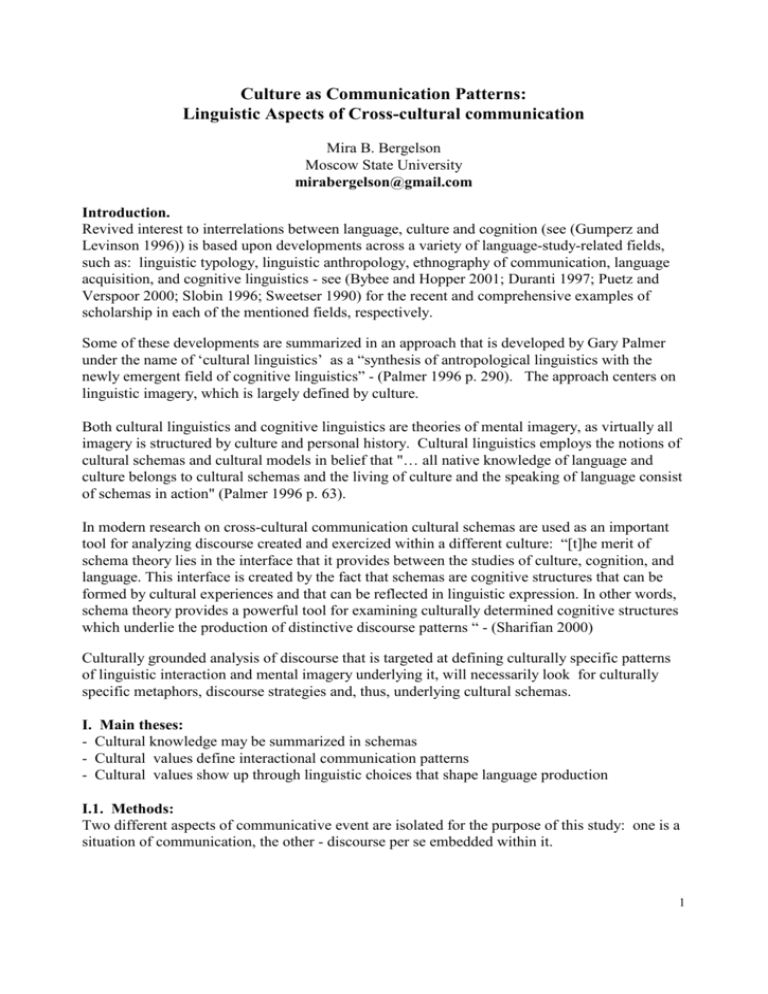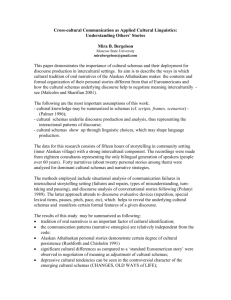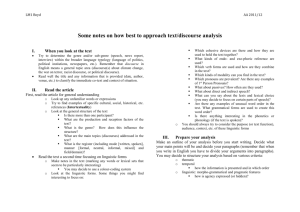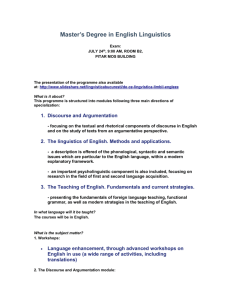Culture as Communication Patterns:
advertisement

Culture as Communication Patterns: Linguistic Aspects of Cross-cultural communication Mira B. Bergelson Moscow State University mirabergelson@gmail.com Introduction. Revived interest to interrelations between language, culture and cognition (see (Gumperz and Levinson 1996)) is based upon developments across a variety of language-study-related fields, such as: linguistic typology, linguistic anthropology, ethnography of communication, language acquisition, and cognitive linguistics - see (Bybee and Hopper 2001; Duranti 1997; Puetz and Verspoor 2000; Slobin 1996; Sweetser 1990) for the recent and comprehensive examples of scholarship in each of the mentioned fields, respectively. Some of these developments are summarized in an approach that is developed by Gary Palmer under the name of ‘cultural linguistics’ as a “synthesis of antropological linguistics with the newly emergent field of cognitive linguistics” - (Palmer 1996 p. 290). The approach centers on linguistic imagery, which is largely defined by culture. Both cultural linguistics and cognitive linguistics are theories of mental imagery, as virtually all imagery is structured by culture and personal history. Cultural linguistics employs the notions of cultural schemas and cultural models in belief that "… all native knowledge of language and culture belongs to cultural schemas and the living of culture and the speaking of language consist of schemas in action" (Palmer 1996 p. 63). In modern research on cross-cultural communication cultural schemas are used as an important tool for analyzing discourse created and exercized within a different culture: “[t]he merit of schema theory lies in the interface that it provides between the studies of culture, cognition, and language. This interface is created by the fact that schemas are cognitive structures that can be formed by cultural experiences and that can be reflected in linguistic expression. In other words, schema theory provides a powerful tool for examining culturally determined cognitive structures which underlie the production of distinctive discourse patterns “ - (Sharifian 2000) Culturally grounded analysis of discourse that is targeted at defining culturally specific patterns of linguistic interaction and mental imagery underlying it, will necessarily look for culturally specific metaphors, discourse strategies and, thus, underlying cultural schemas. I. Main theses: - Cultural knowledge may be summarized in schemas - Cultural values define interactional communication patterns - Cultural values show up through linguistic choices that shape language production I.1. Methods: Two different aspects of communicative event are isolated for the purpose of this study: one is a situation of communication, the other - discourse per se embedded within it. 1 Situational analysis of commuication failures is one research topic that allows to look at a broader context of cross-cultural communication based on ‘contextualization clues’ - (Gumperz 1982). These allow to account for the emerging meanings that are - in the cross-cultural situation very often grounded in different cultural schemas, which may lead to misinterpretation and misunderstanding. Generalizations based on such instances of miscommunication are communication patterns that may reflect or be deducted from certain cultural schemas. Discourse analysis of conversational stories in a certain culture is another way to arrive at cultural schemas. Analysis similar to that of (Polanyi 1989) allows to develop a number of cultural schemas specific for certain genres, but also to get the ‘story of culture’ - a set of propositions that being put together form a narrative exposing this culture’s worldview. Because stories consist of settings, narration of events, and evaluation, what and how is evaluated tells a lot about the storyteller - both as individual and a member of a given culture. Besides the cultural schemas per se, stories are culturally characterized by their discourse structure and compositional conceptual metaphors - (Grady 1997). Both are culturally specific, but relatively independent from the language structures. Thus one may find similar discourse strategies used in stories told in different languages belonging to closely related (if not same) cultures, but differing strategies for the stories told (or translated into) the same language by the representatives of very different cultures. This is reflected in the quality of interpretation, of recall, and general evaluation of stories - see (Kintsch and Green 1978; Scollon and Scollon 1984) for the examples involving Western/Athabaskan storytelling . I.2. Areas: Situational analysis of commuication failures is undertaken using the data of Russian ~Western(American/German) interactions. It is based on huge literature (usually of practicalguide type) and on my personal research. Discourse analysis of conversational stories is exemplified by the data I have gathered during my fieldwork among the Athabaskans of inner Alaska in 20011 and takes advantage of numerous research on Alaskan Athabaskan and White (Nacirema) interaction. I.3. Applications: Cross-cultural communication studies emerged as a result of practical needs of the global society. Findings in this field have a number of most obvious practical applications for workplace communication, for education, and language revitalization efforts. II. Communication patterns. Communication patterns that may rise as different cultural schemas in cross-cultural communication can be categorized into interactional and content-handling groups. 1. Interactional dimension deals with so called ‘politeness phenomena’ - see (Brown and Levinson 1987) which involve presentation of self, distribution of talk, and Face Threatening Acts with numerous politeness strategies to mitigate them. A special point of interest in cross-cultural studies is presence in certain cultures of Face Satisfying Acts (Yuhwei 1994). 1 This fieldwork in the village of Nikolai, Alaska was part of my Fulbright Research Fellowship in May- December 2001. 2 2. Handling-information dimension embraces various strategies ranging in scope from the level of the clause to larger discourse units. It deals with fore- and backgrounding and availability of information reflected in the information structure of a clause/sentence and content organization beyond the sentence. The former, being in many languages part of the grammar, has little to do with cultural schemas and free choice of linguistic form for their speakers. But structuring of discourse at the paragraph (stanza, episode, scene, etc.) level and beyond that is very much culturally bound. Indeed, it often allows to speak of cultures and (sub)cultural groups as of representatives of a certain type of discourse - see (Scollon and Scollon 2001). II.1. Some Russian communication patterns These patterns are characteristic of discourse in educational settings and in workplace (outside of the chain of hierarchy), and in interpersonal communication. 1. Lack of deferential politeness - Expressing and expecting solidarity politeness - FSA: small distance between equals 2. Communication style not targeted at reaching consensus - Starting with ‘njet!’ - Wrong or no answers to your questions - Addressee’s responsibility for information - Potential mistrust of ‘objective truths’ - Parallel processing of information II.2. Russian basic world attitudes (according to (Wierzbicka 1992)) Emotional: relations are more important than reality; interpersonal reality stands for external in many contexts. Not-having-control: the realm of uncontrollable and, thus, unconceivable is broader. Irrational: one can not always rely on objectivized methods of analysis and logic. Judgemental: tendency towards and importance of ethical evaluation. II.3. Introduction to Norhten Athabaskan cultural values 1. Traditional culture - importance of moving - importance of oral tradition - ‘bush consciousness” (Scollon and Scollon 1983) 2. Specific features of Northern Athabaskans’ cultural tradition - industriousness and self-reliance - generosity, mutual aid, and support - individual autonomy - personal restraint and control (Rushforth and Chisholm 1991) II.4. Athabaskan communication patterns 1. Deferential politeness - non-intervention in other’s affairs is expressed literally - Face-Satisfying-Acts: integration of knowledge 2. Handling information dimension: “The listener tells the story” 3 - oral narrative of personal experience - narrator’s role - to give background information - ‘take-it-or-leave-it’ manner II.5. Some formal properties of Athabaskan narratives - avoiding the cultural ‘doublebind’. Performing not telling Concern with formal structuring - signalling the end of verse, stanza, and scene Organizing knowledge through the use of themes Naming actions and postponing conclusions How to use directives in Athabaskan Literature Brown, P. and S. C. Levinson (1987). Politeness : some universals in language usage. Cambridge Cambridgeshire ; New York, Cambridge University Press. Bybee, J. and P. Hopper, Eds. (2001). Frequency and the Emergence of Linguistic Structure. Typological Studies in Language. Duranti, A. (1997). Linguistic anthropology. New York, Cambridge University Press. Grady, J. E. (1997). Foundations of meaning : primary metaphors and primary scenes. University of California, Berkeley. Dept of Linguistics Dissertations. Berkeley: iv, 299 leaves. Gumperz, J. J. (1982). Discourse strategies. Cambridge, Cambridge University Press. Gumperz, J. J. and S. C. Levinson (1996). Rethinking linguistic relativity. Cambridge ; New York, NY, USA, Cambridge University Press. Kintsch and Green (1978). “The role of culture-specific schemata in the comprehension and recall of stories.” Discourse Processes 1: 1-13. Palmer, G. B. (1996). Toward a theory of cultural linguistics. Austin, University of Texas Press. Polanyi, L. (1989). Telling the American story : a structural and cultural analysis of conversational storytelling. Cambridge, Mass., MIT Press. Puetz, M. and M. Verspoor (2000). Explorations in linguistic relativity. Amsterdam ; Philadelphia, J. Benjamins. Rushforth, S. and J. S. Chisholm (1991). Cultural persistence: Continuity in meaning and moral responsibility among the Bearlake Athapaskans. Tucson & London, The University of Arizona Press. Scollon, R. and S. B. K. Scollon (1983). Face in interethnic communication. Language and communication. J. C. Richards and R. W. Schmidt. London ; New York, Longman. Scollon, R. and S. B. K. Scollon (1984). Cooking it up and boiling it down: Abstracts in Athabaskan children's story retellings. Coherence in spoken and written discourse. D. Tannen. Scollon, R. and S. B. K. Scollon (2001). Intercultural communication : a discourse approach. Malden, Mass., Blackwell Publishers. Sharifian, F. (2000). “Aspects of schematic processing in Indigenous speakers of Aboriginal English.” Applied Language & Literacy Research (ALLR) 1(5). Slobin, D. (1996). From "thought and language" to "thinking for speaking". Rethinking linguistic relativity. J. J. Gumperz. 4 Sweetser, E. (1990). From etymology to pragmatics: metaphorical and cultural aspects of semantic structure, Cambridhe University Press. Wierzbicka, A. (1992). Semantics, culture, and cognition: universal human concepts in culturespecific configurations. N.Y., Oxford University Press. Yu-hwei, E. L.-S. (1994). What do "Yes" and "No" really mean in Chinese. Educational linguistics, crosscultural communication, and global interdependence. J. E. Alatis. Washington, D.C., Georgetown University Press. 5









